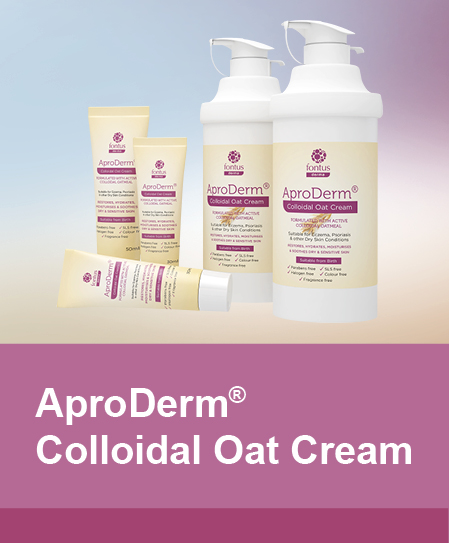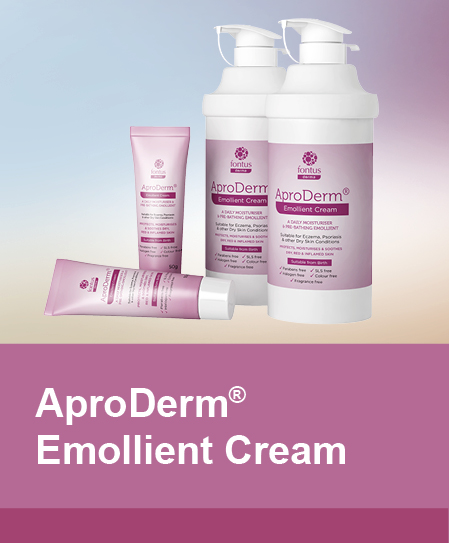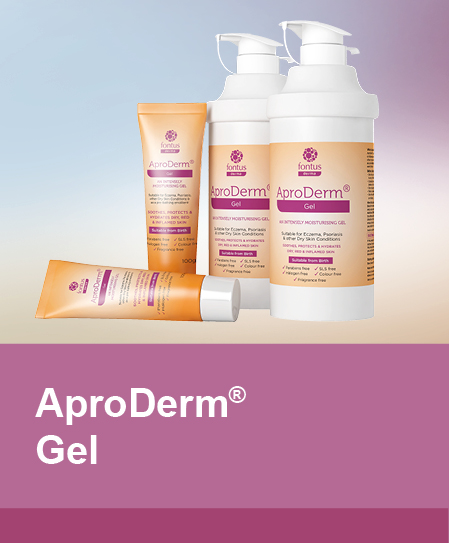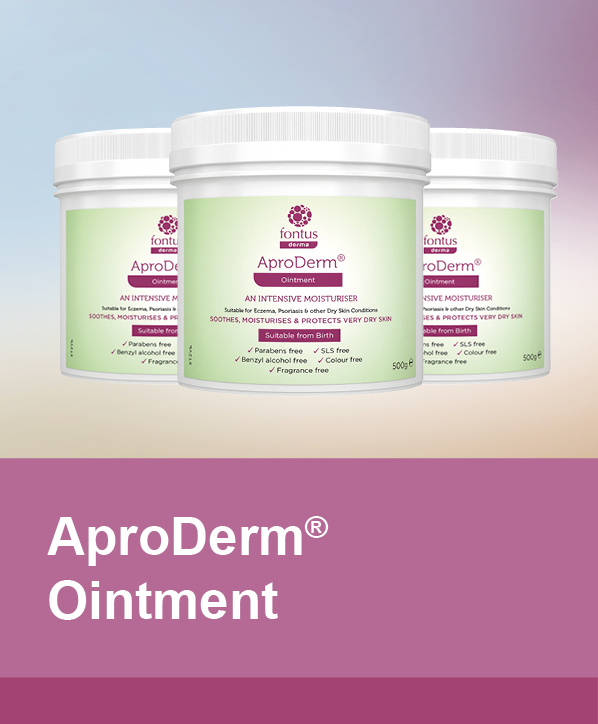Sodium Lauryl Sulfate (SLS)
- A chemical commonly found in numerous cosmetic products including toothpastes, shampoos, soaps, shaving creams and hair products1.
- SLS is a detergent, emulsifier and surfactant which means that it allows oil and water to mix, reduces surface tension, creates foam and cleans2.
- In emollients SLS is used as an emulsifier (allows oil and water to mix) and as a thickening agent to allow the product to be applied easily to the skin3.
- SLS is a well recognised skin irritant and has been shown to decrease natural moisturising factor (NMF) production which means more moisture can be lost from the skin causing it to dry out and making it easier for allergens to enter and cause irritation4.
- In 2010 the results of a study on the effects of aqueous cream on the outer skin layer showed that skin that aqueous cream had been applied to was 12% thinner and had more transepidermal water loss (about 20%) compared to skin that wasn’t treated with aqueous cream and the researchers linked this to SLS5.
1 SLS Free. (n.d.). Sodium Lauryl Sulfate, Learn the Facts and the Potential Dangers. [online] Available at: https://slsfree.net/ [Accessed 18 Apr. 2018]. |
2 Sodium laurilsulfate used as an excipient. (2017). [ebook] London: European Medicines Agency. Available at: http://www.ema.europa.eu/docs/en_GB/document_library/Report/2017/10/WC500235925.pdf [Accessed 18 Apr. 2018]. |
3 Gov.uk. (2013). Aqueous cream: may cause skin irritation - GOV.UK. [online] Available at: https://www.gov.uk/drug-safety-update/aqueous-cream-may-cause-skin-irritation [Accessed 18 Apr. 2018]. |
4 Hoffman, D., Kroll, L., Basehoar, A., Reece, B., Cunningham, C. and Koenig, D. (2013). Immediate and extended effects of sodium lauryl sulphate exposure on stratum corneum natural moisturizing factor. International Journal of Cosmetic Science, [online] 36(1), pp.93-101. Available at: https://www.ncbi.nlm.nih.gov/pubmed/24152302 [Accessed 18 Apr. 2018]. |
5 Tsang M, Guy RH. Effect of Aqueous cream BP on human stratum corneum in vivo. British Journal of Dermatology 2010; 163: 954-958.
Parabens
- Parabens are widely used in cosmetic products such as make-up, moisturisers, toothpastes, nappy creams and hair care products, as well as in some foods and drugs1.
- A group of chemicals that have preservative qualities and protect against microbial growth due to fungi, bacteria and yeast, so prolonging the shelf-life of a product and preventing the transfer of microbial organisms onto a patient’s skin2.
- Common examples of parabens include methylparaben, propylparaben and butylparaben although on product labels they may be listed as hydroxybenzoates1.
- Parabens for the vast majority of the population with normal skin are non-irritating and non-sensitising however paraben sensitisation can occur following repeated low level use (such as from the amount found in emollients) with most cases involving broken or damaged skin3.
- In a study of 121,247 people 1.33% had a reaction to parabens while patients with chronic dermatitis are at an increased risk of parabens sensitisation4. Hence patients with severe eczema and allergic contact dermatitis may benefit from a parabens free treatment regime5.
- In March 2011, following growing concerns over parabens, Denmark banned propyl and butyl parabens and their salts from cosmetic products that were used in children under the age of three6.
- Another study involving 350 Norwegian women found that heavy users of cosmetic products had high levels of parabens in their blood which is worrying as parabens can disrupt hormonal balance in the body and so may impact on fertility7.
1 Fda.gov. (2018). Parabens in Cosmetics. [online] Available at: https://www.fda.gov/cosmetics/productsingredients/ingredients/ucm128042.htm [Accessed 18 Apr. 2018]. |
2 Holland & Barrett. (n.d.). What are parabens and are they bad for you? | Holland & Barrett. [online] Available at: http://www.hollandandbarrett.com/the-health-hub/what-are-parabens-and-are-they-bad-for-you/ [Accessed 18 Apr. 2018]. |
3 Confidentials. (2017). What are parabens and should you be avoiding them?. [online] Available at: https://confidentials.com/liverpool/what-are-parabens-and-should-you-be-avoiding-them [Accessed 18 Apr. 2018]. |
4 Johansen, J., Lepoittevin, J. and Thyssen, J. (2016). Quick guide to contact dermatitis. Springer, p.154. [Available at: https://books.google.co.uk/books?id=BgmkCgAAQBAJ&pg=PA154&lpg=PA154&dq=parabens+sensitisation+in+chronic+dermatitis&source=bl&ots=0wzh9RBodh&sig=4G1B-ajgJ0AK-m7_HTKFGNS-Hq8&hl=en&sa=X&ved=2ahUKEwjr4I2_2ezcAhXEe8AKHfTLC2sQ6AEwDXoECAQQAQ#v=onepage&q=parabens%20sensitisation%20in%20chronic%20dermatitis&f=false |
5 Genuis, S., Birkholz, D., Curtis, L. and Sandau, C. (2013). Paraben Levels in an Urban Community of Western Canada. ISRN Toxicology, [online] 2013, pp.1-8. Available at: https://www.hindawi.com/journals/isrn/2013/507897/#B18 [Accessed 18 Apr. 2018]. |
6 Chemical Watch. (2010). Denmark to ban parabens in children's products. [online] Available at: https://chemicalwatch.com/6217/denmark-to-ban-parabens-in-childrens-products [Accessed 18 Apr. 2018]. |
7 sciencenordic.com. (2012). Stricter EU rules on parabens.
Chlorocresol
- Chlorocresol is found in cosmetics, creams, baby products, paints, adhesives, textile finishes and cooling fluids1.
- A halogen which is known by many other names including Chloro-3-cresol, parachlorometacresol and 4-Chloro-3-methylphenol1.
- Has antiseptic and disinfectant properties and is used as a preservative in pharmaceutical products2.
- Chlorocresol is a sensitiser2
- A UK study involving 3,062 people showed a 0.6% reaction to it3.
1 Huidziekten.nl. (2011). 4-Chloro-3-cresol (PCMC). [online] Available at: https://www.huidziekten.nl/allergie/stoffen/4-chloro-3-cresol.htm [Accessed 18 Apr. 2018]. |
2 Evaluation of active substances: Chlorocresol (CMK). (2018). [ebook] France. Available at: http://dissemination.echa.europa.eu/Biocides/ActiveSubstances/1267-06/1267-06_Assessment_Report.pdf [Accessed 18 Apr. 2018]. |
3 Britton, J., Wilkinson, S., English, J., Gawkrodger, D., Ormerod, A., Sansom, J., Shaw, S. and Statham, B. (2003). The British standard series of contact dermatitis allergens: validation in clinical practice and value for clinical governance. British Journal of Dermatology
Triethanolamine (TEA)
- Triethanolamine (TEA) can be found in up to 40% of products on the market including emollients, cosmetics, perfumes, skin creams, gels and hair dyes1,2.
- Triethanolamine is commonly used as a pH buffer and an emulsifier, allows water and oil to mix3.
- An organic compound which is a by-product of two highly toxic chemicals, ethylene oxide and ammonia2.
- Triethanolamine is recognised as a skin sensitiser by MIMS4 and can cause allergic reactions, dry out skin and hair as well as irritate the eyes2,5. Over extended time, TEA can cause damage to skin in the form of blisters, burning sensation or hives3.
- In Germany, a study on the skin sensitizing properties of ethanolamines found that 323 patients out of 85,098 tested positive6.
- It is recommended by the FDA that the concentration of TEA in a single product must not be above 5%3 and should not be in a product that contains N-nitrosating agents as a mixture of these substances can form carcinogenic products1.
1 Truthinaging.com. (2017). Triethanolamine. [online] Available at: https://www.truthinaging.com/ingredients/triethanolamine [Accessed Sep. 2017]. |
2 Natura Veda. (2017). The Dangers of Triethanolamine. [online] Available at: https://www.naturaveda.com/pages/the-dangers-of-triethanolamine [Accessed Sep. 2017]. |
3 The Dermatology Review. (n.d.). Triethanolamine - The Dermatology Review. [online] Available at: https://www.thedermreview.com/triethanolamine/ [Accessed Sep. 2017]. |
4 Mims.co.uk. (2017). Emollients, Potential Skin Sensitisers as Ingredients. [online] Available at: https://www.mims.co.uk/emollients-potential-skin-sensitisers-ingredients/dermatology/article/882437 [Accessed 8 Mar. 2018] |
5 skinbetter science. (2016). 4 Common Skincare Ingredients to Avoid | skinbetter science. [online] Available at: https://skinbetter.com/4-common-skincare-ingredients-avoid/ [Accessed Sep. 2017]. |
6 Lessmann et al., 2009 - Skin sensitizing properties of the ethanolamines mono-, di-, and triethanolamine. Data analysis of a multicentre surveillance network (IVDK*) and review of the literature
Benzyl Alcohol
- Benzyl alcohol is found in a variety of products ranging from emollients, cosmetics, wound dressings, medicines, soaps through to household and cleaning products1.
- Benzyl alcohol is an aromatic chemical compound that is a fatty alcohol (and not an actual alcohol/spirit). It is used in emollients as a pH adjuster, preservative or as solubilising agent2,3.
- Known by various names such as a-hydroxytoluene, phenylcarbinol, benzylic alcohol and phenylmethyl alcohol.
- Benzyl alcohol toxicity is linked to its accumulation in the individual to a toxic level and it is believed that this accumulation, especially in pre-term neonates, is the cause of the gasping baby syndrome. Characterized by respiratory distress ("gasping"), metabolic acidosis, haematologic abnormalities and death, it was first discovered in 1982 following a series of deaths or severe illnesses in neonates which were linked to intravenous flush solutions and medications containing benzyl alcohol4,5.
- As there has been no clear study to indicate the safety of benzyl alcohol at ‘low-levels’, the FDA advised that products for infants should be benzyl alcohol free. The EMA guideline on the use of benzyl alcohol and benzoic acid states that benzyl alcohol must not be used in pre-term and full-term neonates, also it’s not recommended for children under 3 years5,6.
- Benzyl alcohol poisoning can result through oral, dermal, inhalation and ocular routes7.
- Benzyl alcohol use in adults has been associated with hypersensitivity reactions, including contact dermatitis and nausea. It has been found to be irritating to the skin at levels 3% or more in adults. Several studies show benzyl alcohol is an irritant in adults causing not only skin reactions but also causing bronchitis (1995)5,7,8.
1 SkinSAFE. (n.d.). benzyl alcohol Ingredient Allergy Safety Information. [online] Available at: https://www.skinsafeproducts.com/ingredients/benzyl-alcohol [Accessed Apr. 2018]. |
2 Nair, B. (2001). Final Report on the Safety Assessment of Benzyl Alcohol, Benzoic Acid, and Sodium Benzoate. International Journal of Toxicology, 20(3_suppl), pp.23-50. |
3 Benzyl Alcohol as Preservative for Intravenous Solutions. (1984). Pediatrics in Review, 6(5), pp.139-157. |
4 Medscape. (2018). Pediatric Pharmacotherapy Part 1: The History of Pediatric Drug Therapy. [online] Available at: https://www.medscape.com/viewarticle/726236_2 [Accessed 9 Feb. 2018]. |
5 Buck, M., Roberts, R., Hendrick, A., Belgado, B. and Estes, S. (1996). A Guide to Pharmaceutical Excipients. Pediatric Pharmacotherapy, (Volume 2 Number 9). |
6 EMA, 2017. Benzyl alcohol and benzoic acid group used as excipients. (2017). European Medicines Agency. Available at: http://www.ema.europa.eu/docs/en_GB/document_library/Report/2017/10/WC500235920.pdf [Accessed 9 Feb. 2018]. |
7 Toxnet.nlm.nih.gov. (2015). BENZYL ALCOHOL - National Library of Medicine HSDB Database. [online] Available at: https://toxnet.nlm.nih.gov/cgi-bin/sis/search/a?dbs+hsdb:@term+@DOCNO+46 [Accessed 9 Feb. 2018]. |
8 Reynolds, R. and Smith, R. (1995). Nebulizer Bronchitis Induced by Bacteriostatic Saline. JAMA: The Journal of the American Medical Association, 264(1), p.35.
Fragrances
- Fragrances can be found in emollients, cosmetics, perfumes, creams, wet wipes, toilet paper and washing powder1.
- Fragrances are added to many products including emollients to make them more appealing and to mask any unpleasant smells that may be a necessary part of the product. These fragrances can be natural or synthetic and are thought to affect the user’s perception of the product and contribute to skin feel and acceptability in using the product.
- Fragrances, however, are one of the most frequent causes of allergic contact dermatitis from cosmetic products and the second most common cause of positive patch test results after nickel, with certain fragrance chemicals e.g. isoeugenol, cinnamal and citral being quite potent sensitisers2.
- Approximately 1.0% – 4.2% of the population are sensitised to fragrance materials whilst in those with eczema this figure can be as high as 14%. Fragrances will often exacerbate existing dermatitis so a treatment that is fragrance free may be beneficial in those with already sensitive skin3,4.
- The American Contact Dermatitis Society voted fragrance as Allergen of the Year in 20075 in an attempt to highlight both its abundance in everything from cosmetics and cleaning products to foods and medications as well as it’s potential to be an allergenic substance in the development of dry skin conditions.
- To test for fragrance allergies a person is tested with a mix of fragrances – there are two types of fragrance mixes Mix I and II, Mix I contains 8 different fragrances and Mix II consists of 6. A positive response indicates a fragrance allergy to one or more of the fragrances in the mix and it is advised that those affected should avoid products containing perfumes and stick to fragrance free products6.
1 Cosmeticsinfo.org. (n.d.). Fragrance | Cosmetics Info. [online] Available at: http://www.cosmeticsinfo.org/ingredient/fragrance [Accessed 18 Apr. 2018]. |
2 Wohrl, S., Hemmer, W., Focke, M., Gotz, M. and Jarisch, R. (2001). The significance of fragrance mix, balsam of Peru, colophony and propolis as screening tools in the detection of fragrance allergy. British Journal of Dermatology, 145(2), pp.268-273. |
3 Peiser, M., Tralau, T., Heidler, J., Api, A., Arts, J., Basketter, D., English, J., Diepgen, T., Fuhlbrigge, R., Gaspari, A., Johansen, J., Karlberg, A., Kimber, I., Lepoittevin, J., Liebsch, M., Maibach, H., Martin, S., Merk, H., Platzek, T., Rustemeyer, T., Schnuch, A., Vandebriel, R., White, I. and Luch, A. (2011). Allergic contact dermatitis: epidemiology, molecular mechanisms, in vitro methods and regulatory aspects. Cellular and Molecular Life Sciences, 69(5), pp.763-781. |
4 Ec.europa.eu. (n.d.). 2. What kind of skin problems are known to be caused by fragrance ingredients? - European Commission. [online] Available at: http://ec.europa.eu/health/scientific_committees/opinions_layman/perfume-allergies/en/l-3/2-skin-problems.htm [Accessed 18 Apr. 2018]. |
5 Contactderm.org. (n.d.). History of Allergen of the Year - American Contact Dermatitis Society. [online] Available at: https://www.contactderm.org/i4a/pages/index.cfm?pageid=3467. |
6 Fragrance allergy could be missed without patch testing with 26 individual fragrance allergens. (2016). Contact Dermatitis, 74(4), pp.230-235.
Colours
- Colours are common place in all aspects of life including pigments found in textile dyes, permanent make-up, hair dyes and medications.
- One example is p-Phenylenediamine (PPD), a common colourant in permanent hair dyes whose sensitising effect is well recognised and has been studied and documented in numerous case reports and research papers over the years1.
1 p-phenylenediamine. (2000). [ebook] EPA. Available at: https://www.epa.gov/sites/production/files/2016-09/documents/p-phenylenediamine.pdf [Accessed 18 Apr. 2018].






